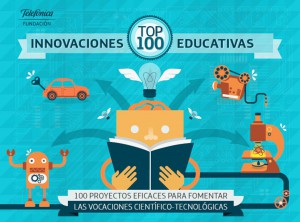 Chema Alonso
Chema Alonso
Chief Data Officer, Telefonica.
 Last week, Fundación Telefónica organized an event to present a new Fundación Telefónica Challenge, a worldwide study searching for the best educational innovations to promote scientific and technological careers among young people in Spain.
Last week, Fundación Telefónica organized an event to present a new Fundación Telefónica Challenge, a worldwide study searching for the best educational innovations to promote scientific and technological careers among young people in Spain.
In the first part of the event, Pablo Gonzalo, Head of Fundación Telefónica Challenge, gave the audience a detailed view of the study, deepening in its different sections. In the second part of the event, the innovators of the best 3 educational innovations awarded provided an overall view of their innovations.
Here are the issues raised in this challenge:
1) Why promoting scientific and technological careers?
Developing STEM (Science, Technology, Engineering and Mathematics) skills is crucial for fostering a competitive economy capable of addressing the real challenges of society –knowledge‐based, environmentally friendly and socially inclusive – and unfortunately, every year, fewer and fewer young people in the EU choose these study options
2) What to do in order to promote scientific and technological careers?
- Identify the factors that impact on the choice of study. These factors can be classified into four broad groups:
-
- Educational
- Psychological
- Informative
- Social
- Identify educational innovations to address this challenge and ways of positively influencing these four factors:
- Improving the acquisition of STEM skills (Educational factor)
- Encouraging pupils to actively examine their skills and interests and how they match STEM requirements (Psychological factor)
- Providing academic and professional advice about job prospects in the scientific and technical sectors (Informative factor)
- Improving the social image of STEM degrees (Social factor)
- Educational: Inappropriate teaching methods
- Psychological:
- Unfavourable perception of STEM among young people.
- Gender stereotypes that dissuade girls from choosing STEM options.
- Informative: Ignorance about the job prospects for STEM graduates.
- Social:
- Family prejudices regarding the suitability of STEM careers for their children.
- Poor perception of vocational training in STEM.
4) Which innovations can address these barriers?
- Pedagogical innovations that:
- Improve the acquisition of STEM skills: knowledge, abilities and attitudes.
- Encourage students to identify their own abilities to carry out STEM tasks.
- Provide students with information about STEM careers and their potential.
- Improve the social perception of STEM careers.
- Organisational innovations that encourage synergies between the different actors (school, business, university, government, media) in order to carry out activities related to the key factors, guaranteeing that the desired impacts are achieved and can be sustained over time.
5) Which requirements must meet these innovations?
- Tested innovation
- Significant implementation
- Scalable
- Defined sustainability model
6) Which are the criteria to assess the relevance and suitability of the innovations for implementation in Spain and Latin America?
- Potential impact on the local context (30%).
- Capacity of execution/implementation in the local context (25%).
- Sustainable economic model (25%).
- Degree of innovation (10%).
- Speed of results (10%).
Amongst all the projects presented in this challenge, the top 3 educational innovations awarded were the following:
- Apps for good: Helena Murphy explained that Apps for Good is an open-source technology education movement born in the UK which goal is to transform the way technology is taught in schools; to empower students from all backgrounds to seize the opportunities of our digital age and create solutions to the problems they care about, using technology.
- Jump Math: John Mighton (Canada) commented that JUMP Math’s mission is to enhance the potential in children by encouraging an understanding and a love of math in students and educators. He also noted that JUMP Math believes that all children can be led to think mathematically, and that with even a modest amount of attention every child will flourish. By demonstrating that even children who are failing math or who are labeled as slow learners can excel at math, Jump Math hopes to dispel the myths that currently prevail.
- ScienceLab: Heike Schettler(Germany) explained that this initiative consists on an approach and learning model to science that makes children of 4 to 10 years of age the leaders of their own learning process. This initiative, applicable inside and outside the school, allows children to get the necessary knowledge, skills and abilities to help them questioning their environment and looking for answers through experimentation.
For more information on Fundación Telefónica Challenge click here.
For more information on Fundación Telefónica initiatives click here.








